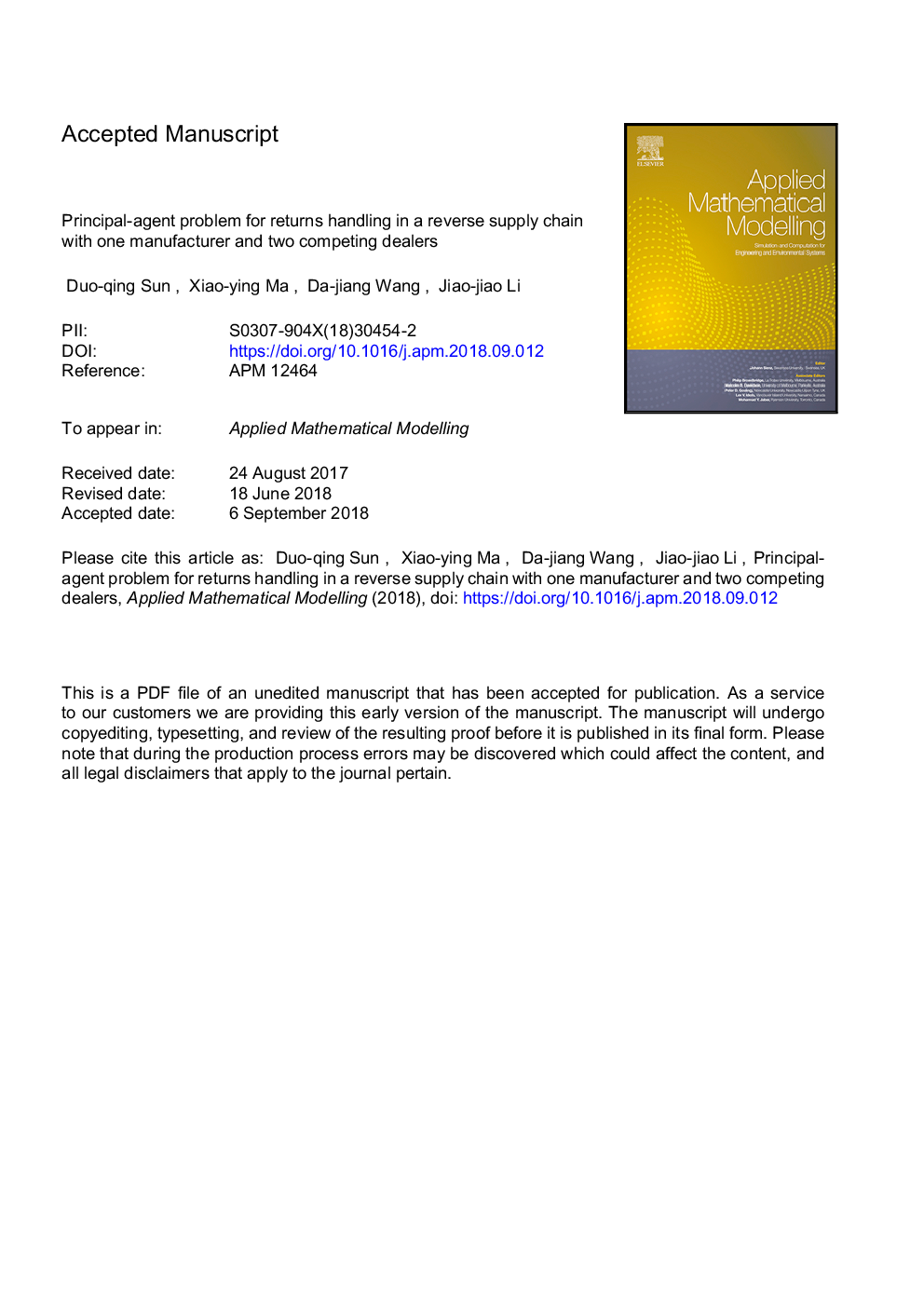| کد مقاله | کد نشریه | سال انتشار | مقاله انگلیسی | نسخه تمام متن |
|---|---|---|---|---|
| 11026483 | 1666378 | 2019 | 42 صفحه PDF | دانلود رایگان |
عنوان انگلیسی مقاله ISI
Principal-agent problem for returns handling in a reverse supply chain with one manufacturer and two competing dealers
ترجمه فارسی عنوان
مشکل اصلی عامل برای بازگشت به دست آوردن در یک زنجیره عرضه معکوس با یک تولید کننده و دو نمایندگی مجاز و فروش
دانلود مقاله + سفارش ترجمه
دانلود مقاله ISI انگلیسی
رایگان برای ایرانیان
کلمات کلیدی
مدیریت زنجیره تامین، بازده دست زدن، عامل عمده عامل، قرارداد مشوق، عادلانه، قضیه نقطه ثابت،
ترجمه چکیده
با تمرکز بر مشکل اصلی عامل در دست زدن به محصولات جدید که توسط مشتریان در زنجیره عرضه معکوس با یک تولید کننده و دو نمایندگی مجاز و متقاعد شده است، بررسی می کنیم که چگونه سازنده انگیزه نمایندگی های خود را برای تلاش های خود برای مدیریت و فروش محصولات جدید بازگشتی با استفاده از مدل سازی ریاضی با در نظر گرفتن عقلانیت فردی نمایندگی مجاز و فروش، قراردادهای مطلوب مشوق را تحت هر دو اطلاعات متقارن و نامتقارن ایجاد می کنیم و بینش های زیر را به دست می آوریم. در وضعیت اطلاعات متقارن، سطح تلاش نمایندگی ها با کسانی که به حداکثر رساندن سود کل انتظار زنجیره تامین یکسان است، یکسان است. اما در وضعیت اطلاعات نامتقارن، سطح تلاش های نمایندگی ها پایین تر از بهینه ترین زنجیره تامین است. علاوه بر این، در صورت تشدید رقابت بین نمایندگی مجدد، سطح تلاش آنها افزایش می یابد، در حالی که هر سهم درآمد فروشنده از تولید کننده کاهش می یابد و هزینه های مربوط به ریسک، انگیزه و کل آژانس های کل زنجیره تامین کاهش می یابد. سهم درآمد با عدم اطمینان بازگشت معکوس است. هنگامی که یک فاکتور محیط زیست تصادفی را که بر بازدهی قرارداد مشوق معرفی می شود معرفی می کنیم، این سهم درآمد با افزایش سطح تلاش های نمایندگی ها افزایش می یابد، در حالیکه هزینه های فوق کلیه سیستم کاهش می یابد و این هماهنگی سیستم های زنجیره تامین را بهبود می بخشد. پیوستن عدالت به مدل اصلی-عامل موجب افزایش بیشتر در سطوح تلاش نمایندگی ها می شود، که با استفاده از قضیه نقطه ثابت ثابت می شود. در نهایت، ما یک نمونه برای نشان دادن نتایج اصلی ارائه می دهیم.
موضوعات مرتبط
مهندسی و علوم پایه
سایر رشته های مهندسی
مکانیک محاسباتی
چکیده انگلیسی
Focusing on the principal-agent problem in handling new-products returned by customers in a reverse supply chain with one manufacturer and two competing dealers, we investigate how a manufacturer motivates her dealers to exert their efforts to handle and sell the returned new-products using mathematical modelling. By taking into consideration the dealers' individual rationalities, we design optimal incentive contracts under both symmetric and asymmetric information and obtain the following insights. In the symmetric information situation, dealers' effort levels are identical to those maximising the expected overall profit of the supply chain. In the asymmetric information situation, however, the dealers' effort levels are lower than the supply chain optimum. Further, in the case of intensifying competition between the dealers, their effort levels increase, while each dealer' revenue share received from the manufacturer decreases and the risk, incentive and total agency costs of the entire supply chain tend to diminish. The revenue share is inversely correlated with return uncertainties. When we introduce another random environmental factor affecting returns into the incentive contract, this revenue share increases with a rise in dealers' effort levels, while the above-mentioned costs of the entire system decline and this improves the supply chain system coordination. The incorporation of fairness into the principal-agent model promotes a further increase in the dealers' effort levels, which is proved using the fixed-point theorem. Finally, we provide an example to demonstrate the main results.
ناشر
Database: Elsevier - ScienceDirect (ساینس دایرکت)
Journal: Applied Mathematical Modelling - Volume 66, February 2019, Pages 118-140
Journal: Applied Mathematical Modelling - Volume 66, February 2019, Pages 118-140
نویسندگان
Sun Duo-qing, Ma Xiao-ying, Wang Da-jiang, Li Jiao-jiao,
